What’s a CentiMorgan, Anyway? How DNA Tests for Family History Measure Genetic Relationships
If you’re doing DNA tests for family history, you may see lots of predicted cousin matches: 2nd, 3rd, 4th, etc…..But what does that predicted genetic relationship actually mean? Learn about centimorgans, the powerful genetic genealogy unit of measure, and how it helps your research.
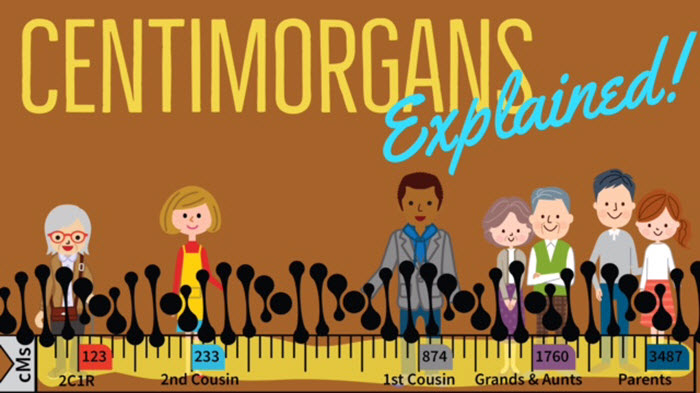
How DNA Tests Measure Genetic Relationships
 When we are looking at genetic relationships, there are also many ways we can measure them. But ultimately, we want the testing company to tell us how likely it is that a particular individual shares a single, recent common ancestor with us. One factor in this calculation is to take into account the total amount of DNA we share with that match.
When we are looking at genetic relationships, there are also many ways we can measure them. But ultimately, we want the testing company to tell us how likely it is that a particular individual shares a single, recent common ancestor with us. One factor in this calculation is to take into account the total amount of DNA we share with that match.
Currently, all the testing companies are reporting this sum in centimorgans (cMs). Every company reports to you the total number of shared cMs, as outlined below.
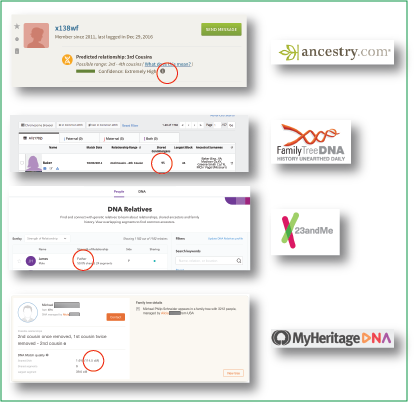 AncestryDNA: Click on the match to access the personal profile page for that match. In the second section, under Predicted Relationship, you will see the confidence level. To the right of the confidence level, you will see a grey circle with a little “i” in it. Clicking there will show you the total amount of shared cMs as well as how many pieces of DNA you share.
AncestryDNA: Click on the match to access the personal profile page for that match. In the second section, under Predicted Relationship, you will see the confidence level. To the right of the confidence level, you will see a grey circle with a little “i” in it. Clicking there will show you the total amount of shared cMs as well as how many pieces of DNA you share.- Family Tree DNA: On the main match page for your Family Finder results, you will see the total amount of shared cMs in the third column.
- 23andMe: You can see the percentage of shared DNA from the main DNA Relatives home page. To convert the percentage into centimorgans, just multiply your percentage by 68 (that will at least get you close). You can also see total shared cMs in the chromosome browser tool (go to Tools > DNA Relatives > DNA).
- MyHeritageDNA: The total amount of shared DNA is shown on the main match page under the title Match Quality. MyHeritage also has a new DNA Match Review page. Click here to read more about that.
Centimorgan: A Genetic “Crystal Ball”
 It is very tempting to think of a cM just like you would think of an inch or a centimeter, and for all practical purposes, that is okay. But it is actually much more complicated than that.
It is very tempting to think of a cM just like you would think of an inch or a centimeter, and for all practical purposes, that is okay. But it is actually much more complicated than that.
A cM is actually more like a crystal ball: it helps us predict how likely a piece of DNA looks exactly as it did a generation ago. This, in turn, helps us calculate how far back we should be looking for the common ancestor between two people.
But for our practical purposes, you can use the total amount of shared DNA, in combination with this chart compiled by Blaine Bettinger and the Shared cM Project, to better assess your genealogical relationship with your match based on your genetics.
To use the chart, take the total amount of shared DNA you have with a match, and look up that number in the chart to get an idea of what kind of genealogical relationship might best fit the genetics that you see. For example, if I share 69 cM with my match, we might be third cousins. But we might also be second cousins once or twice removed.
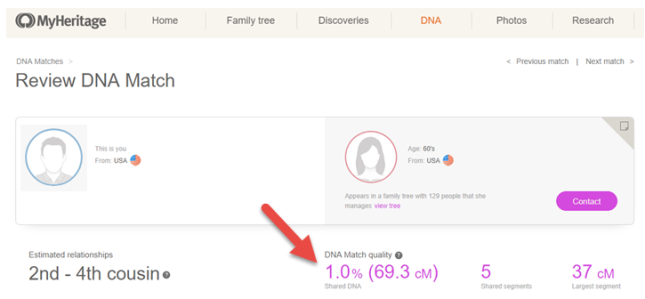
How do you figure out which one? Simply put: do genealogy research! It’s time to use traditional records and research skills to better understand the genetic clues in your family history mysteries.
My series of DNA quick reference guides can help you get the most out of your DNA tests for family history. I definitely recommend the value-priced bundle of all 10 guides. But I especially recommend the guides listed below if you’re to the point where you’re trying to understand what genetic relationships mean:
- A Guide to AncestryDNA
- A Guide to Family Finder at Family Tree DNA
- A Guide to 23andMe DNA
- Breaking Down Brick Walls with DNA
- Organizing Your DNA Matches
Thanks for sharing this post with someone who would enjoy reading it! You’re a gem!
Disclosure: This article contains affiliate links and Genealogy Gems will be compensated if you make a purchase after clicking on these links (at no additional cost to you). Thank you for supporting Genealogy Gems!

Solutions for Broken Website Links
Every genealogist has experienced the frustration of clicking on a link and discovering that the page is gone or the resource is now defunct. Things change rapidly as technology evolves, so it’s a problem that isn’t going away any time soon.
Genealogy Gems Podcast listeners often ask what to do when they run across a broken or defunct website in the show notes of older episodes of The Genealogy Gems Podcast. I’ve got answers for you today that can help you get back on track whenever this happens to you.

I received this email from a listener of the free Genealogy Gems Podcast, and it’s one I’ve received from lots of listeners and genealogists alike:
“As one of your podcast listeners who is working my way through past episodes, I am running into a bit of frustration that I am wondering if you, on someone else reading this, can help me on. I have tried to get to a couple of websites that guests of yours mentioned, with no success. (I’m listening to episodes from) 2010, where I am at now, (and that) may not be all that long ago for many, but it is an eon in internet terms.
Are you, or anybody else reading this, aware of any person or site tracking genealogy related websites that records/posts notations of name changes, buy-outs by other service providers, or just plain disappearances? You might have mentioned some in the interim, but I’m still a hundred episodes in arrears.”
That’s the wonderful thing about podcasts, you can listen when the episode is published or even a decade later. That’s because podcasts, unlike radio shows, are recordings that you can access whenever it’s convenient for you. But my listener is correct, things change quickly online, and that includes website links I refer to in the show notes web pages of older episodes.
How to Find Information When a Website has Disappeared
I love hearing that listeners are enjoying the free Genealogy Gems Podcast archive. We hear over and over that our listeners pick up something new each time they listen. However, I completely understand the frustration of encountering defunct websites and resources. What a bother they are!
Unfortunately with the speed at which online information changes, it’s just about as impossible to keep years of web content current (while still producing new content) as it is finding a genealogy record that burned in a courthouse fire!
The good news is that with a little persistence, you can probably locate where a source has moved to or find alternatives that may provide the same function. Paying attention to clues and details around the original source itself can lead you to alternatives that can accomplish the same goals or provide the same or similar information. And of course, tracking down information that’s gone missing is certainly a valuable skill in all areas of genealogy!
Here are a few great strategies to help you find information when a website has disappeared:
1. The Wayback Machine Can Find Defunct Sites
1) If you run across a link to a now defunct site, copy the website link. Next, go to the Internet Archive at https://web.archive.org and paste the web address that you copied into the Wayback Machine search field. Press enter on your keyboard to run the search on that address. You may very likely be able to retrieve a screenshot of the page.

If you’ve been researching your family history for several years, you’ll probably recognize the screenshot of World Vital Records (below) at the Wayback Machine.

You may not gain access to everything that was there originally, but you’ll very likely glean clues that you can use to find the information you seek on another website using a Google search.
One of the features most recently added to the Wayback Machine is the Save Page Now tool. This helps you capture web pages and add them to the Wayback Machine at the time that you find them. That way, even if the site goes away, you’ll have a copy of the web page for future reference.
This tool works on any web page that allows “crawlers”, which most sites do. Crawlers are used by sites like Google and the Wayback Machine to index information and capture the pages.
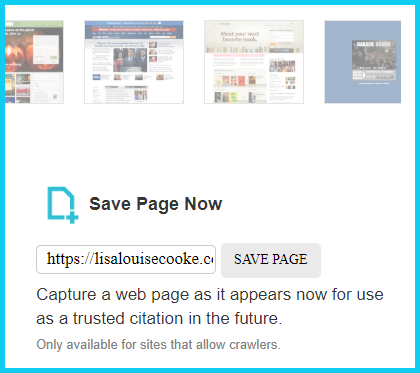
To save a web page using the Wayback Machine, copy the web page’s address and paste it into the Save Page Now field. It will bring up the page in your browser and show you that it’s being processed and will be added to the Wayback Machine.
The page will be conveniently stamped with the date that it was captured. This is helpful because even though websites may stay online for years to come, the content on their pages may be changed over time. By using the Save Page Now feature and adding the web page to the Wayback Machine, you will be able to revisit the information that was on that page on that specific date well into the future, regardless of changes that may be made to it over time.
2. Google Your Question
You’ve heard me say it many times: Just Google it! And that certainly applies here. Google is great at finding alternative sources for the same information. No question is a dumb question when it comes to Google.
If you are running into a challenge with a defunct site or have a question, chances are someone else has had the same question! It may have been posted on a message forum, a blog post or the help section of a website. Google can help you find the question and the answers that were provided.
Let’s say you come across a link to the World Vital Records website in the syllabus of a class you took several years ago. (If you’ve been researching your family history for a while, then you probably remember this genealogy records website.) And imagine that when you type the link into your web browser, you discover that the link is broken and the website no longer exists.
Here’s an example of what you could ask Google in order to find out what has happened to the World Vital Records website:
- When did world vital records close?
- Sunset notice for World Vital Records
- Who acquired World Vital Records?
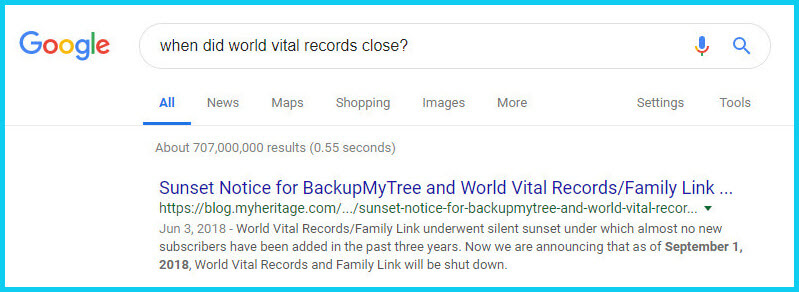
As you can see in the example search in the image above, the sunset notice for World Vital Records, which was acquired by MyHeritage, was issued in September of 2018. Click the link to the article to read up on all the details.
When faced with a broken link your first impulse may be to ask another person or someone you see as an expert on the subject. That can work too, but chances are they may just ask you “did you Google it?” That’s because, like it or not, Googling at the moment you have the question is much faster and provides you with the latest information.
Think of Google as asking your question to every single web page in the world – all at once. If the answer is out there, Google can probably find it.
3. Google the Content
As I said, the internet is growing and changing every day and it is very possible you may find the content is now available elsewhere.
Any good source that provides website URLs will usually include information about what you’ll find on that website. You can use that information to run a Google search. Your goal is to determine if the information you seek is available elsewhere from the same provider, or identify another website that references the same content.
Start by copying short phrases of key information and pasting it into the Google search box. Put quotation marks around the text. Quotation marks are a standard Google search operator and they will tell Google to search for web pages that include that exact phrase, sentence or paragraph. (Quotation marks also work on individual words such as surnames.) If you don’t get an exact search result, remove the quotation marks and place them just around the most important individual key words.
Here’s an example of how this works:
In Genealogy Gems Podcast episode 62 (published back in 2009) I talked with actor Darby Hinton about a new history-themed television series he was producing called Hintons Living History. The show notes include a link to the website devoted to the show. Clicking that link leads to an error page because the website has since been taken down. (For website publishers like myself, we are often faced with the decision between creating new content, or constantly combing through old published content to fix what is out of date. I think you will agree that continuing to create new content is preferable.)
Since the link no longer works, a Google search of the name of the television show in quotation marks (“Hintons Living History”) provides a plethora of information and videos to learn more about the show.
Obvious, But Not Always
While the solutions I’ve shared here may seem somewhat obvious, time and time again I’ve watched people get befuddled by running into broken genealogy website links. It’s totally understandable. In the excitement of the moment of finding something interesting, getting stopped in your tracks by a broken links creates frustration. Our brains tend to focus on that obstacle and frustration rather than the simple solutions that are available.
Now you have a game plan that you can use so that broken links will only be a blip on your genealogical research path.
This article was originally written in January 2019, and extensively updated August 6, 2019. Can you find the old version on the Wayback Machine?
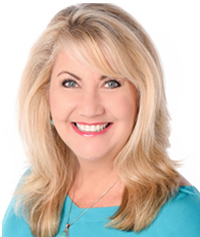 About the Author: Lisa Louise Cooke
About the Author: Lisa Louise Cooke
Lisa is the Producer and Host of the Genealogy Gems Podcast, an online genealogy audio show and app. She is the author of the books The Genealogist’s Google Toolbox, Mobile Genealogy, How to Find Your Family History in Newspapers, and the Google Earth for Genealogy video series, an international keynote speaker, and columnist for Family Tree Magazine.
British Isles Descendants Will Love these New Records Online
Millions of British Isles descendants—whether still living in England, Scotland, Ireland and Wales or dispersed to the United States, Canada, Australia or New Zealand, may find their ancestors in these new online records that include medieval maps, BMD and immigration...Join me at MyHeritage LIVE Tel Aviv 2020
I was honored to speak at the first MyHeritage LIVE conference in Oslo, Norway in 2018. After another rousing success in Amsterdam in 2019, the event is coming to Israel in 2020. I’ll be there speaking along with many of your favorites. MyHeritage LIVE is an event like no other that you won’t want to miss. Here are all the details from the folks at MyHeritage.
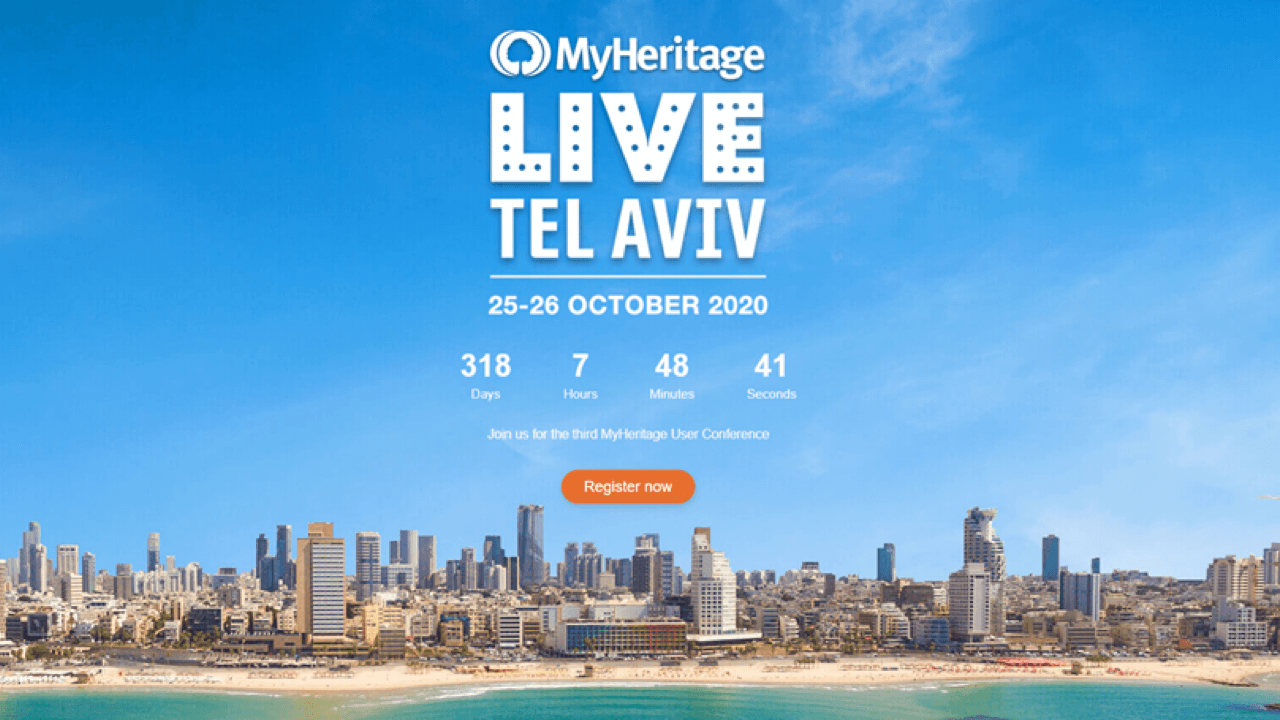
From Daniel Horowitz, Genealogy Expert at MyHeritage:
Following the success of MyHeritage LIVE 2018 and 2019, I am delighted to announce that our third annual MyHeritage LIVE conference will take place from 25–26 October 2020 at the Hilton Tel Aviv in Israel!
As one of the most celebrated genealogy events of the year, MyHeritage LIVE brings together family history enthusiasts, top international experts, and MyHeritage staff for two days of fascinating lectures covering the latest topics in genealogy and DNA. Each year, hundreds of MyHeritage users from around the world attend.
The venue is situated right on the Tel Aviv coastline with breathtaking views of the Mediterranean Sea. This year’s conference presents you with a wonderful opportunity to connect with fellow genealogy enthusiasts and tour a unique and beautiful country steeped in ancient history.
In addition to a plenary session from MyHeritage Founder and CEO Gilad Japhet, there will be multiple lectures, panels, and workshops covering genealogy and DNA, as well as sessions from local speakers covering Israeli resources and Jewish genealogy.
We’ve lined up an excellent array of international speakers including:
- Roberta Estes,
- Thomas MacEntee,
- Dick Eastman,
- Diahan Southard,
- and Lisa Louise Cooke.
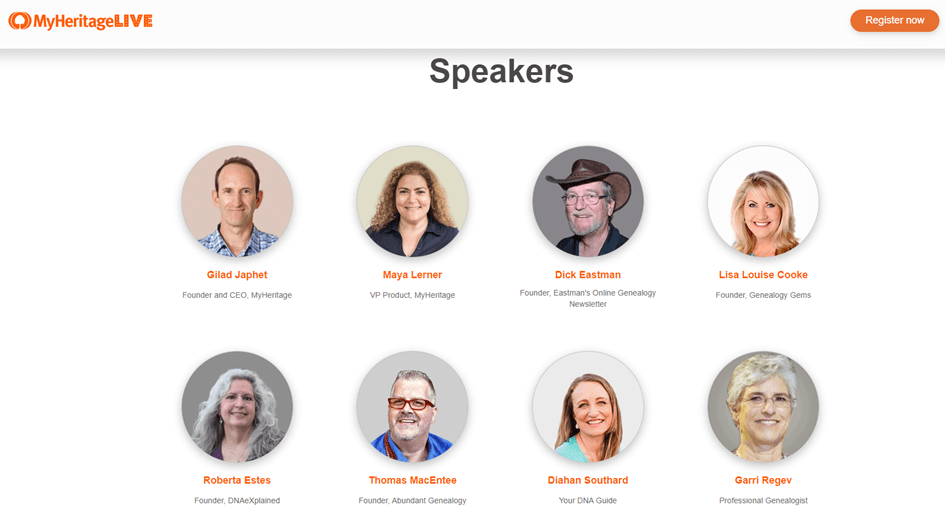
Joining them from Israel will be Garri Regev and Rony Golan along with others to be announced soon.
From the MyHeritage team, you’ll also hear from Maya Lerner, VP Product; Schelly Talalay Dardashti, U.S. Genealogy Advisor; Michael Mansfield, Director of Content Operations; Daniel Horowitz, Genealogy Expert; and more.
We’d be delighted if you share this news with your followers and let them know that they can register now on the MyHeritage LIVE 2020 website to secure early bird pricing of $100 per ticket.
MyHeritage LIVE Conference Details:
From the MyHeritage Blog:
“MyHeritage LIVE 2020 will take place on October 25–26, 2020 at the Hilton Tel Aviv. Set in landscaped Independence Park, this upscale hotel is a short 8-minute walk from the Mediterranean beachfront and just 5 km from the Tel Aviv-Savidor Center train station.
If you haven’t visited Tel Aviv yet, now is your chance to experience a beautiful, vibrant city that’s known as a “city that never sleeps,” making it a perfect fit for night owl genealogists who toil late into the night to work on their research. Explore the past and experience new cultures in a truly unique country steeped in ancient history.”
Tickets
Conference tickets include access to lectures, workshops, coffee breaks, lunches, and the MyHeritage party, all of which you don’t want to miss!
Past events
Both MyHeritage LIVE 2018 in Oslo, Norway, and MyHeritage LIVE 2019 in Amsterdam, the Netherlands received tremendous praise from conference participants, who declared the events some of the best conferences they’ve ever attended.
There were three different tracks: DNA, genealogy, and hands-on workshops. Riveting talks by guest speakers and MyHeritage staff captivated full audiences. MyHeritage Customer Support representatives were on hand throughout the conference to provide comprehensive, hands-on support.
Watch the 2019 Highlights:
Watch My Presentation from MyHeritage LIVE 2018
How to Find Your Family in Newspapers with SuperSearch:

